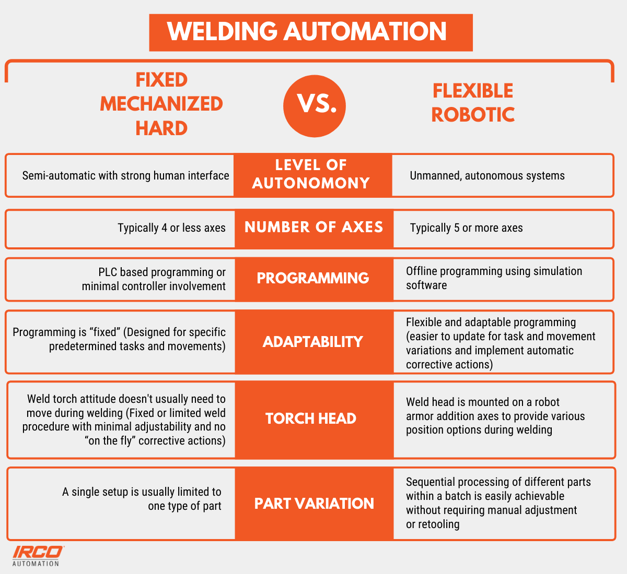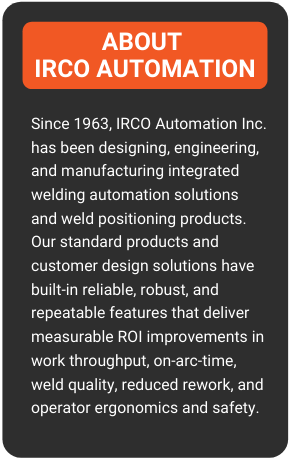Did you know that the ancient Egyptians used welding to join metal pieces together? The art of welding has been around for centuries! Over the last few decades, however, technology has led to significant advancements in welding. Today, a variety of manufacturing processes make use of welding automation. Yet, despite it's popularity, understanding the different types of welding automation (and which is best for your process) can be an overwhelming challenge.
In this blog, we'll explain and simplify the main types of welding automation to help you start to understand which would be the best choice for your manufacturing process.
Sections in this post:
- Introduction/Review:
- Types of Welding Automation
What Different Types of Welding Automation are there?
Brief Overview: What is Welding Automation?
Welding automation is a term that describes a diverse range of equipment, software, and devices that help automate the process of welding. The best and most efficient automated welding systems are designed specifically for your operation and aren’t cookie-cutter solutions. Depending on the process (or particular stage of it) you are trying to automate, there are varying degrees of automation possible.
To learn more about what welding automation is, check out this resource: What is Welding Automation?
Brief Overview: The Benefits of Welding Automation
There are several process improvements and benefits that welding automation can help provide. Some of the challenges an automated welding system may help address are:
- Increasing productivity
- Providing greater repeatability
- Reducing safety hazards
- Improving weld quality
- Reducing cycle times
- Shortage of qualified welders
To learn more about the benefits of welding automation, check out this resource: The benefits of Welding Automation
What are the different types of Welding Automation?
It's easy to understand how the word automation draws quick associations in people's minds to robotics. Robots are part of cartoons, movies, and everyday conversations. You can imagine what a robot might look like, you know they can do things automatically, and how they can help us with a variety of different tasks. But automation refers to more than just robotics. So, investing in welding automation doesn't always mean you're purchasing a robotic arm with a torch head to carry out your welding (although in some cases, it might be that!). There are more options available and possible.
Welding automation can be split into different types or categories. For example, this is a list of category names common to the industry:
- Fixed welding automation
- Flexible welding automation
- Mechanized welding Automation
- robotic welding automation
- Hard Welding Automation
People use some the names in the list above almost interchangeably, but generally, there are two main groups (or types) of welding automation:
.png?width=625&name=WELDING%20AUTOMATION%20(7).png)
To explain the difference between the two types here's bullet point break down:
Fixed/Mechanized/Hard Welding Automation
- Semi-automatic with strong human interface
- Typically four or less axes
- PLC based programming or minimal controller involvement
- Programming is “fixed” (Designed for specific predetermined tasks and movements)
- Weld torch attitude doesn't usually need to move during welding (Fixed or limited weld procedure with minimal adjust-ability and no “on the fly” corrective actions)
- A single setup is usually limited to one type of part
Flexible/Robotic Welding Automation
- Unmanned, autonomous systems
- Typically five or more axes
- Offline programming using simulation software
- Flexible and adaptable programming (easier to update for task and movement variations and implement automatic corrective actions)
- Weld head is mounted on a robot arm or addition axes to provide various position options during welding
- Sequential processing of different parts within a batch is easily achievable without requiring manual adjustment or retooling
Here's a side-by-side comparison:

The Walk, Crawl, Run theory of Welding Automation
When determining what type of welding automation might be the best for your process, our team at IRCO Automation also considers the level of interaction and involvement you want your welders or operators to have with the system. We break it down into three levels and describe it as Crawl, Walk and Run:
[MORE INFO BELOW THE INFOGRAPHIC]
How To Get Started With Welding Automation
You might have a better picture now of what type of welding automation is available.... But what are you're next steps? What are some things your team can talk through before even calling a specialist or requesting a quote? We have a new resource coming soon on this specific question.
In the meantime, keep in mind that the best and most efficient automated welding systems will be designed specifically for your process. Generic products on the market might offer to thousands of different options, but you're likely interested in only a few specific things. Take a moment to determine to reflect on your manufacturing process and determine what your most significant challenges are.
What's Next?
Ready to get started? Or have specific questions?
Connect with our team about your project by either:
- Filling out this form and providing a few details
- Or, booking a phone/video call with one of our welding automation specialists at a time that is most convenient for your schedule
Looking to learn more?
Check out these resources:
- Automated Beam Welding Systems
- What are the benefits of welding Automation?
- Welding Automation - Turn-key Solutions

.png)
.png?width=600&name=Author%20Headers%20(7).png)
.png?width=627&name=Walk%2c%20Crawl%2c%20Run%20(1).png)

